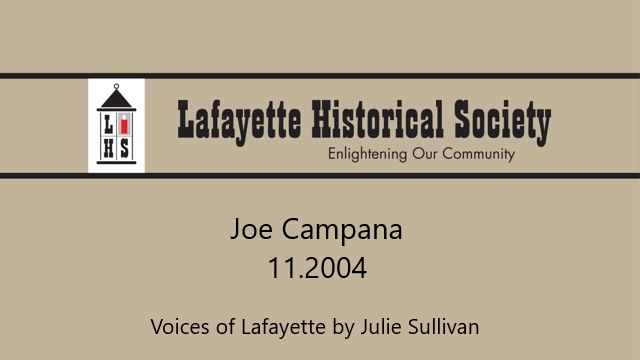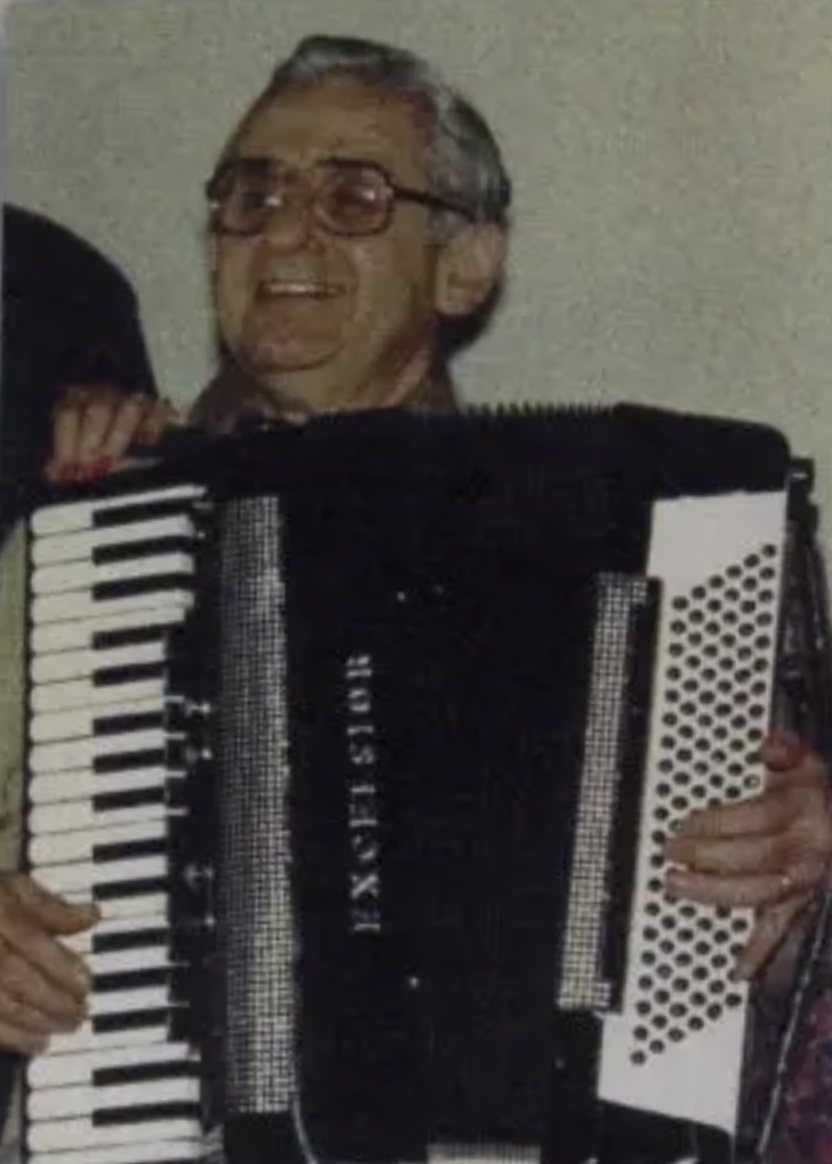Summary:
Joe Campana was interviewed by Julie Sullivan in November, 2004. He owned and ran Campana Music for 57 years. Born in 1920, Joe served in Europe and Africa in World War II and came back to Lafayette determined to own his own business. He had learned how to play the accordion as a boy and, having decided that “Music was the only thing I wanted to do,” he proceeded to open his store and recruit students. For almost six decades he supplied the community with instruments–which he repaired as well as sold and leased–lessons, and sheet music.
Oral History:
The walls of Joe Campana’s Moraga Road office are a visual history, not just of Lafayette but of the world at large. Joe, owner of Campana Music for fifty-seven years, smiles down on the visitor alongside celebrities like Dinah Shore and former Raiders’ coach, Tom Flores. Photos of sports teams Campana has sponsored, a Diablo Magazine poster proclaiming Campana Music ‘the place to shop in the East Bay,’ and hand-written notes from Petar of Petar’s restaurant fame are all preserved in a space crammed with a half-century of music memorabilia.
Singer John Gary and jazz great Wes Montgomery have also visited the store. “I remember when some limos pulled up in the parking lot,” Joe reminisces. “Tennessee Ernie Ford walked in with his entourage. He was passing through town and decided to stop by. He asked if I had any of his records and autographed all of them.”
Joe was born in Oakland in 1920, served in Europe and Africa during World War II, and returned from the war to work in his uncle’s Oakland plumbing business. “My folks bought me an accordion when I was nine years old, and I took private music lessons,” he says.
“After the war the world changed. People’s attitudes changed. They wanted to be their own bosses. They’d tell their boss I didn’t want to do this or I didn’t want to do that. I saw the light immediately when I got back and decided to go out on my own.
“Music was the only thing I wanted to do. After the war I started teaching the accordion on the side, picking up students. The accordion in the 30’s, 40’s and 50’s was as popular as the guitar is today. Then I decided I wanted to open a music store. My wife and I used to drive out to Lafayette on weekends where all the hay fields were and say ‘someday we’re going to live out here.’” Joe and his wife of almost sixty-four years, Fannie, have two children, a son and a daughter, numerous grandchildren and two great grandchildren. “I wanted to open in Walnut Creek because it was more developed, but there was already a music store, Reilly’s, there,” Joe recalls. “This was right after the war and there weren’t any empty buildings. The government controlled all building equipment, and nobody was building. My original store around the corner (Moraga Road and Mt. Diablo Boulevard) is a tailor shop now. I moved there in June, 1947. Lafayette looked like the promised land.”
Joe remembers Marie’s restaurant, run by a German couple. “Their son, Eddie Bill, is still around. It was behind where World Savings (now Wachovia) is, a little building in the back. On the weekends everybody would come out of the hills to eat there. In front at the Associated Gas Station, the owner would sit out in a rocking chair reading the newspaper. He was about 80 and pumped gasoline with an old hand pump.”
Kids sometimes rode to Joe’s store on horseback for their music lessons and tied the horses up outside. Joe remembers Jay Bedsworth’s Tunnel Inn (later Petar’s) next door to “the brick building they just remodeled” (Pizza Antica). Jay Bedsworth was the original owner, and Petar bought it from him. Jay was a magician. He went around the table and did card tricks, a real personality. He had a deck of cards, and you would pick out a card and he’d put a thumb tack in it and throw it up on the ceiling, where it stuck.” Later Petar’s moved to the present location at Lafayette Circle when the old building was torn down.
“The Penny Saver grocery was around where Trader Joe’s is now,” Joe recalls. “Mickey Meyers had a grocery on the corner where Starbucks is. Then Sparling took over in the same building and put a drug store in it.”
At first Joe commuted from Albany. “My wife would come out on the Greyhound bus in the afternoons,” he remembers. “I had my students on the other side of the tunnel, and while I was giving lessons there, my wife would be running the store here. I’d leave my house at 6:30 a.m. and get to Lafayette at 7:00 a.m. and start teaching kids the accordion before school. Women were playing the accordion a lot, too. Then I’d give lessons after the store closed and get home around 11 at night. I did that for a number of years, until I finally got enough students in this area. It took about seven years of real struggle.” The family moved to Lafayette in 1951.
“One of my other reasons for coming out this way was that I had to get franchises from the instrument manufacturers. In Oakland they already had Sherman and Clay; that was the largest music store in the area. So I figured if I opened a little store in Lafayette I’d be able to get some franchises,” he explains. “I bought from wholesalers in San Francisco, but I couldn’t buy big name band instruments. In the beginning I had sheet music, lessons, instruments. Now we rent instruments to people, but not in the beginning. I had a company in Oakland I rented accordions from, because I couldn’t afford to buy them. In those days an accordion started around $150, and now that same instrument runs about $750 on up to $10,000 or 15,000 if you get into electronics. When we first started out, music lessons were two dollars for a half hour. Today they start at twenty-five dollars on up, depending on the teacher.
“At first, it was just my wife and me in the store. Both my kids worked part time. It was just hard work, and it’s still hard work. I get here around 7:30 a.m. till 6:30 p.m. six days a week. People don’t want to work like I had to any more. You have to have a lot of money nowadays to open a store, because of inventory and rents.
“I was in my first store around the corner for six years, when Mr. Garibotti, a fellow paisano, came over. He owned a lot of property. He said, ‘I’m going to build a building over there (the west side of Moraga Road, across from Joe’s current store at #990A).’ Around 1953 we moved to Garibotti’s new building. It looked exactly like the one where Kinko’s is today, except the original building came all the way out to the sidewalk. There was Fiesta Market on the end, Sam Napolitano’s barber shop in the back, Carl Geshke had the hardware store, then my music store, Sutton’s Shoes, a children’s store, and Dorothy Foster’s gift shop. We sold TV’s and radios in the early 1950’s, Magnavox and Zenith. We had a TV service department with two repair men, John Lehto and Bert Landes, but we got out of the TV business later. I got into the record business around the same time. I had three record booths where you could play records, 78’s, 45’s and 33 1/3’s. High school kids used to come in. We sold 8-track tapes, then cassettes.
“I stayed in the Garibotti building until 1968, St. Patrick’s Day, when the entire building was destroyed in a fire. Fiesta Market had some refrigeration units in the attic that shorted out. We had a common attic, so the whole building went. When they rebuilt it, the city made them push it back and put parking in front.”
Joe had already bought the site for his current store at the time of the fire. “It had a little building on the lot where the Greyhound bus picked up passengers and an apartment upstairs. Mr. Fowler, the owner, ran the bus station,”Joe remembers. After the fire, Greyhound canceled their rental, and Joe used the existing structure until his current building was completed in 1970. Thirty-five years later, he’s still operating from the multi-level rustic timber building designed by local architect E. G. Craig.
Currently, the basis of Joe’s business is lessons, sales and rentals, sheet music and instrument repair. Joe does all the repairs himself in a crowded room overflowing with tools on the bottom level of the store. Upstairs on the top level are studios where twelve teachers give music lessons.
“This isn’t the easiest area to be in business,” Joe states. “You’ve got to keep going all the time. In the 1990’s when CD’s came in, we got out of the record business. We couldn’t compete with the big stores like Tower Records in terms of inventory. Now we’ve got a lot of competition with the E-Bay’s and people buying on the Internet. It’s a crazy world. I stay in this corner of the world. This is my corner.”
Excerpted from “Voices of Lafayette” by Julie Sullivan. This book is available for purchase in the History Room.



Leave a Reply